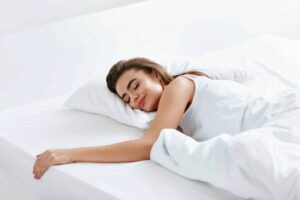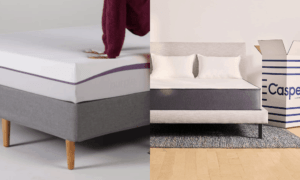Polysleep Mattress Review
Disclosure: By clicking on the product links in this article, Mattress Nerd may receive a commission fee at no cost to you, the reader. Read full disclosure statement.
Is the Polysleep Mattress For You?
Who’s Going to Love the Polysleep Mattress
- Back sleepers and Side sleepers
- Hot sleepers who want the cushioning of foam
- Budget-conscious shoppers
Who Should Steer Clear of the Polysleep Mattress
- Those with heavyweight (> 230 lbs) body types—instead, the Big Fig mattress is designed to support those with bigger bodies.
- Most stomach sleepers—instead, look for a medium-firm or firm mattress, like the Luxury Firm and Firm versions of the Saatva Classic mattress.
- Those looking for the bounce and breathability of coils—instead, opt for an innerspring or hybrid mattress like the Helix Midnight mattress.
The Polysleep is a Canadian all-foam mattress made with antimicrobial foam that helps to reduce allergy symptoms at night. It has a medium firmness that best suits average-weight back and side sleepers.
We recommend this mattress for the following sleeper types: Financing options are available for this mattress. The Polysleep is a Canadian all-foam mattress made with antimicrobial foam that helps to reduce allergy symptoms at night. It has a medium firmness that best suits average-weight back and side sleepers.
We recommend this mattress for the following sleeper types: Financing options are available for this mattress. The Polysleep is a Canadian all-foam mattress made with antimicrobial foam that helps to reduce allergy symptoms at night. It has a medium firmness that best suits average-weight back and side sleepers.
We recommend this mattress for the following sleeper types: Financing options are available for this mattress.Polysleep Mattress
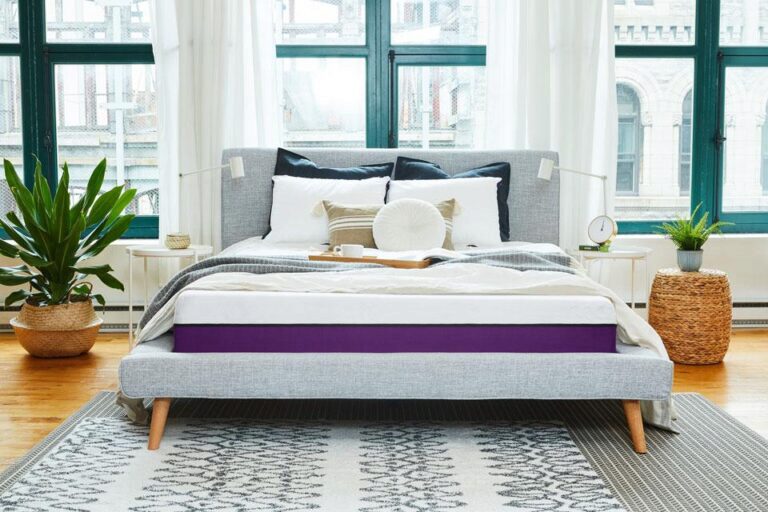
Material
Foam
Trial Period
100 nights
Shipping Method
Free shipping
Firmness
Medium-firm: 6/10
Warranty
10-year warranty
Price Range
$$$$$
Hot Sleepers
If you often overheat while you sleep, this mattress should help you stay cool.
Couples
This bed has great motion isolation so you will not feel your partner tossing and turning at night.
Back Pain
This bed is perfect for anyone suffering from back pain.
Back Sleeping
Ideal for lightweight and average weight back sleepers.
Side Sleeping
Ideal for lightweight side sleepers.
Financing Options
Polysleep Mattress

Material
Foam
Warranty
10-year warranty
Firmness
Medium-firm: 6/10
Shipping Method
Free shipping
Trial Period
100 nights
Price Range
$$$$$
Hot Sleepers
If you often overheat while you sleep, this mattress should help you stay cool.
Couples
This bed has great motion isolation so you will not feel your partner tossing and turning at night.
Back Pain
This bed is perfect for anyone suffering from back pain.
Back Sleeping
Ideal for lightweight and average weight back sleepers.
Side Sleeping
Ideal for lightweight side sleepers.
Financing Options

Polysleep Mattress
Material
Foam
Firmness
Medium-firm: 6/10
Trial Period
100 nights
Warranty
10-year warranty
Shipping Method
Free shipping
Price Range
$$$$$
Hot Sleepers
If you often overheat while you sleep, this mattress should help you stay cool.
Couples
This bed has great motion isolation so you will not feel your partner tossing and turning at night.
Back Pain
This bed is perfect for anyone suffering from back pain.
Back Sleeping
Ideal for lightweight and average weight back sleepers.
Side Sleeping
Ideal for lightweight side sleepers.
Financing Options
Polysleep Mattress Firmness and Feel
Polysleep Mattress Firmness
On the 1–10 firmness scale we use here at Mattress Nerd, the Polysleep has a firmness level of 5/10, which is smack dab in the middle of the scale. Most mattresses with this medium-firmness work well for a wide variety of sleepers, since they balance support with pressure relief.
What Does the Polysleep Mattress Feel Like?
The Polysleep’s top layer of foam has a plush feel that’s easy to compress under weight. The denser transition and base foam layers of the mattress provide support, so you don’t sink all the way through the mattress.
Those who prefer firm, supportive mattresses or who have a heavier body type may find that the Polysleep provides comfortable pressure relief at first but doesn’t give them adequate support throughout the night.
Support and Pressure Relief by Sleeping Position
Back Sleepers
Lightweight and average-weight back sleepers who prefer soft mattresses should enjoy this bed. When you first lie down, its comfort layer cradles your body, and the support of the transitional and base layers keeps the hips and shoulders elevated on an even plane.
The Polysleep is softer than most heavyweight back sleepers prefer, so we recommend a more supportive mattress or one from our best mattresses for back sleepers roundup.
Stomach Sleepers
Stomach sleepers need a mattress that will keep their hips from sinking, which will ultimately prevent low back pain caused by spinal misalignment. The Polysleep’s softer feel works against it for stomach sleepers, and we think most folks who prefer this sleeping position will find that their hips sink too far down for good alignment.
Lightweight stomach sleepers may be able to sleep comfortably on this mattress, but those with average-weight and heavyweight body types should check out the best mattresses for stomach sleepers.
Side Sleepers
The Polysleep is an okay mattress for side sleepers. Its top layer offers noticeable cradling that allows the hips and shoulders to sink down and for the spine to settle into a healthy position. Lightweight and average-weight side sleepers should feel comfortable and aligned on their sides, though average-weight folks may notice some pressure near their shoulders.
Heavyweight side sleepers are more likely to sink through the soft top layers and come into contact with the bed’s firmer, supportive core, which could cause tension in the hips and shoulders.
Combination Sleepers
If you sleep primarily on your side and back, the Polysleep mattress could be a great fit. Its top foam layer is soft, but it doesn’t give you the “stuck” feeling that sometimes accompanies memory foam.
You should be able to change positions with relative ease whether you’re a lightweight, average-weight, or heavyweight combination sleeper. Still, if you spend a lot of time on your stomach or weigh over 230 lbs, you’ll want to check out the best mattresses for combination sleepers instead.
| Body Type: | BACK SLEEPERS | STOMACH SLEEPERS | SIDE SLEEPERS |
| Lightweight (< 130 lbs): | 5 | 3 | 4 |
| Average weight (130 – 230 lbs): | 4 | 2 | 3 |
| Heavyweight (> 230 lbs): | 2 | 2 | 2 |
1 = Very poor, 2 = Not good, 3 = Fair, 4 = Good, 5 = Excellent
Polysleep Mattress Performance
Is the Polysleep Mattress Cooling?
The top layer of the Polysleep mattress is a hybrid foam (specifically, a polyfoam) that’s aerated for improved airflow. This helps the Polysleep stay cooler than memory foam beds. If you tend to stay just right or a little warm, the aeration should be enough to keep you cool at night. Those who struggle with sleeping hot should opt for a cooling mattress, like those with breathable coils or gel-infused foam.
Edge Support
The Polysleep has a high-density foam perimeter that’s designed specifically to improve edge support. This built-in support frame wraps around the sides of the mattress, and works to keep it from flattening when you spread out or sit along the edges. With that said, we noticed a lot of sinkage when we sat on the edges of the Polysleep.
Responsiveness
While an all-foam construction doesn’t typically provide as much bounce as a hybrid or innerspring mattress, the Polysleep’s top layer of foam has a pretty quick response to pressure. This makes it easier to move around on. You’ll feel like you’re sleeping “in” the mattress rather than “on” it, but it shouldn’t feel like the foam is preventing you from changing positions or getting out of bed.
Motion Isolation: Is it good for those who share a bed?
Softer beds tend to absorb more motion than firmer and more responsive mattresses. The Polysleep has three layers of foam that do an average job of reducing motion transfer, but there are better mattresses for couples who wake easily when their partner, pet, or co-sleeping child stirs.
Noise
Foam beds are usually quiet, thanks to the absence of potentially squeaky coils. The Polysleep mattress stayed silent during our testing process.
Pain Relief
Whether or not a mattress relieves (or prevents) pain is really contingent on how well it’s compatible with your body type and sleeping position. Generally, you want a mattress that’s supportive and pressure-relieving.
For side sleepers, that usually means a softer bed that evenly distributes your body weight. The Polysleep does only an average job of cushioning pressure points, so it’s a good fit for side sleepers under 230 lbs, but not for those with pre-existing shoulder or hip pain.
Stomach sleepers need a firm mattress that keeps their hips lifted to prevent lower back pain. The Polysleep is too soft for most stomach sleepers, but lightweight folks who spend only part of the night on their front should be okay. Back sleepers are the easiest to please, and should be fine on the Polysleep as long as they like a softer bed and weigh less than 230 lbs.
Related: Best Mattresses for Back Pain
Sex
The Polysleep isn’t the best mattress for sex, but it’s also not the worst. It scores about average in all the categories we look at for sex: ease of movement, temperature, and noise. Some couples may want the bounce of a mattress with coils, and in that case, they should look elsewhere.
Off-Gassing
Polysleep mattresses are made with foams that receive a CertiPUR-US certification. This ensures the foams are free of harmful chemicals. If you notice off-gassing (a new mattress smell), it’s non-toxic and should be gone within a few hours or days.
Durability
Foam beds are the least durable beds on the market, since they have a tendency to form body impressions. Fortunately, the Polysleep mattress has a top layer with a 3.0 lb composition, which, in mattress-talk, means it’s top tier in quality. The other foam layers are also high quality; plus, the mattress is warranted for 10 years.

Polysleep Mattress Construction: What’s it made of?
The Polysleep combines three CertiPUR-US certified layers of foams of varying densities and a liquid repelling cover.
Liquid Repellent Cover: The cover is a standard polyester blend that’s removable and liquid repellant to help minimize damage from spills or accidents. The sides of the cover are made of mesh to make the bed more breathable. While the cover is removable, it’s not machine washable and should be spot cleaned with a mild detergent.
Viscoelastic Hybrid Foam: The top layer of the Polysleep is high quality polyfoam with antimicrobial properties. This comfort layer is contouring under pressure points and easily compresses under body weight. There are small holes punched through the foam to help improve airflow and breathability.
Proprietary Support Frame: The foam support frame wraps around the mattress, and is designed to prevent sinking around the perimeter. If you sit on the bed to tie your shoes or read a book, you’ll appreciate the extra support.
Polyfoam Transitional Layer: A polyfoam transition layer prevents the body from sinking too much into the firmer foam base layer. It helps provide the ideal mix of comfort and support by acting as a bridge between the soft top layer and the dense base.
Foam Support Layer: A base layer of support foam provides stability to the layers above and improves the mattress’s durability.
How Much Does the Polysleep Mattress Cost?
| Mattress Size | Price | Dimensions | Height | Weight |
| Twin | $925 | 39” x 75” | 10” | 41 lbs. |
| Twin XL | $975 | 39” x 80” | 10” | 43 lbs. |
| Full | $1,100 | 54” x 75” | 10” | 54 lbs. |
| Queen | $1,225 | 60” x 80” | 10” | 62 lbs. |
| King | $1,375 | 76” x 80” | 10” | 80 lbs. |
| California King | $1,375 | 72” x 84” | 10” | 82 lbs. |
For more great prices on a new mattress, check out our Best Mattress Deals of 2024.
How Do the Policies Measure Up?
Shipping & Unboxing
As a direct-to-consumer Canadian company based in Montreal, Polysleep ships its mattresses free to Canadian Provinces and the contiguous United States. Additional shipping charges apply for shipping to Alaska and Canadian Territories. For similar choices, see the best mattresses in Canada.
The Polysleep mattress ships as a bed-in–a-box, and delivery typically takes place two to nine days after you place your order. It took us two minutes to unbox our Polysleep, and it stayed pretty flat for a few minutes, but eventually fluffed up to its full shape after a few hours.
Warranty
Polysleep offers a 10-year warranty for the Polysleep mattress. This limited warranty begins on the date of purchase and extends to the original purchaser only. It covers indentations deeper than 1”, splitting or cracking of the foam, and flaws in the cover’s zipper.
If your mattress is proven defective during its warranty period, Polysleep will repair or replace the mattress once. The warranty is valid 10 years from the date of purchase as long as the bed is on a supportive bed base or box spring and is used for its intended purpose.
Trial Period & Returns
The Polysleep mattress comes with a 100-night sleep trial period, so you have more than three months to test out the mattress. If you’re not satisfied, you can contact the Polysleep team at support@polysleep.com to initiate an exchange or a return for a full refund. Polysleep will coordinate mattress pickup, and used mattresses are donated to charity.
Addressing Polysleep Mattress Complaints
Too Firm
Several customers complained that the Polysleep mattress is too firm for comfort. Mattress firmness is subjective, so what feels soft to an average-weight person may feel uncomfortably firm to a lightweight person.
We rate the Polysleep mattress at 5/10, or having a medium firmness, but we gave it only an average score for pressure relief, which means you may notice some pressure near your shoulders or hips.
Not Durable
A handful of Polysleep customers commented that their mattress lost support after only a few months, and after their trial period had ended. Like firmness, comfort is subjective to each person, but if your Polysleep mattress develops a dip that’s deeper than 1” that’s not caused by an unsupportive bed frame, you can make a warranty claim and receive a replacement mattress.
Comparing the Polysleep Mattresses
Polysleep Mattress vs. Polysleep Origin Mattress
The Polysleep Origin is an all-foam mattress made with conforming memory foam and durable support foam. It features an antimicrobial treatment that keeps odor build-up to a minimum. Plus, the foams have a breathable construction that stays cooler.
We recommend this mattress for the following sleeper types: Financing options are available for this mattress. The Polysleep Origin is an all-foam mattress made with conforming memory foam and durable support foam. It features an antimicrobial treatment that keeps odor build-up to a minimum. Plus, the foams have a breathable construction that stays cooler.
We recommend this mattress for the following sleeper types: Financing options are available for this mattress. The Polysleep Origin is an all-foam mattress made with conforming memory foam and durable support foam. It features an antimicrobial treatment that keeps odor build-up to a minimum. Plus, the foams have a breathable construction that stays cooler.
We recommend this mattress for the following sleeper types: Financing options are available for this mattress.Polysleep Origin Mattress
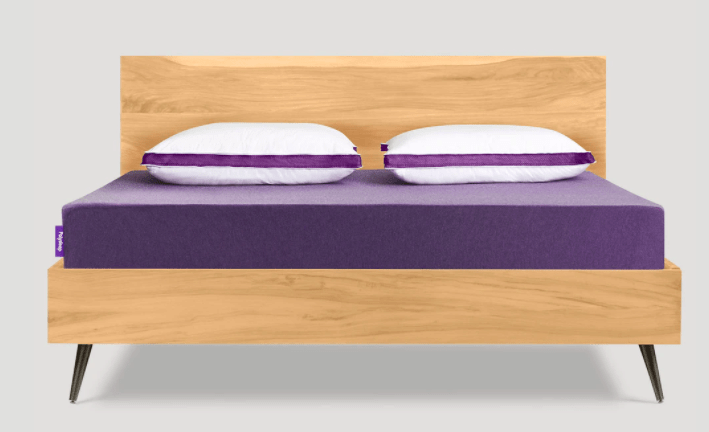
Material
Foam
Trial Period
100 nights
Shipping Method
Free shipping
Firmness
Medium-firm: 6/10
Warranty
10-year warranty
Price Range
$$$$$
Back Sleeping
Ideal for lightweight and average weight back sleepers.
Side Sleeping
Ideal for lightweight side sleepers.
Financing Options
Polysleep Origin Mattress

Material
Foam
Warranty
10-year warranty
Firmness
Medium-firm: 6/10
Shipping Method
Free shipping
Trial Period
100 nights
Price Range
$$$$$
Back Sleeping
Ideal for lightweight and average weight back sleepers.
Side Sleeping
Ideal for lightweight side sleepers.
Financing Options

Polysleep Origin Mattress
Material
Foam
Firmness
Medium-firm: 6/10
Trial Period
100 nights
Warranty
10-year warranty
Shipping Method
Free shipping
Price Range
$$$$$
Back Sleeping
Ideal for lightweight and average weight back sleepers.
Side Sleeping
Ideal for lightweight side sleepers.
Financing Options
While both of these all-foam mattresses use antimicrobial foam to help sleepers manage allergies and fight bacteria, the Polysleep mattress has three foam layers, while the Origin has only two. The Origin also lacks the foam support frame that the Polysleep mattress has for extra edge support. Instead of a liquid repelling cover, the Origin has a moisture-wicking cover.
The Origin is more affordable than the Polysleep, but it has only a five year warranty instead of a 10-year warranty.
See our full Polysleep Origin Mattress Review to learn more.
Polysleep Mattress vs. Zephyr Mattress
The Zephyr is an all-foam mattress by Polysleep that includes nanobionic technology aimed at improving muscle recovery. Multiple foam comfort layers and a targeted zone base layer help to keep you supported and comfortable.
We recommend this mattress for the following sleeper types: Financing options are available for this mattress. The Zephyr is an all-foam mattress by Polysleep that includes nanobionic technology aimed at improving muscle recovery. Multiple foam comfort layers and a targeted zone base layer help to keep you supported and comfortable.
We recommend this mattress for the following sleeper types: Financing options are available for this mattress. The Zephyr is an all-foam mattress by Polysleep that includes nanobionic technology aimed at improving muscle recovery. Multiple foam comfort layers and a targeted zone base layer help to keep you supported and comfortable.
We recommend this mattress for the following sleeper types: Financing options are available for this mattress.Polysleep Zephyr Mattress
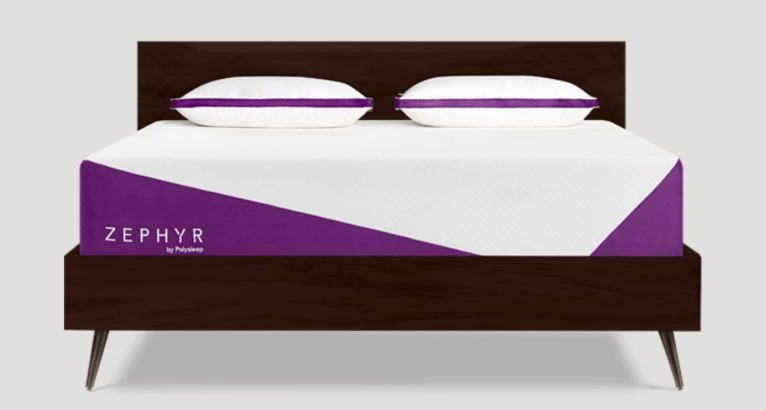
Material
Foam
Trial Period
100 nights
Shipping Method
Free shipping
Firmness
Medium-soft: 4/10
Warranty
10-year warranty
Price Range
$$$$$
Back Sleeping
Ideal for lightweight, average weight, and heavyweight back sleepers.
Side Sleeping
Ideal for lightweight and average weight side sleepers.
Financing Options
Polysleep Zephyr Mattress

Material
Foam
Warranty
10-year warranty
Firmness
Medium-soft: 4/10
Shipping Method
Free shipping
Trial Period
100 nights
Price Range
$$$$$
Back Sleeping
Ideal for lightweight, average weight, and heavyweight back sleepers.
Side Sleeping
Ideal for lightweight and average weight side sleepers.
Financing Options

Polysleep Zephyr Mattress
Material
Foam
Firmness
Medium-soft: 4/10
Trial Period
100 nights
Warranty
10-year warranty
Shipping Method
Free shipping
Price Range
$$$$$
Back Sleeping
Ideal for lightweight, average weight, and heavyweight back sleepers.
Side Sleeping
Ideal for lightweight and average weight side sleepers.
Financing Options
The Zephyr mattress is the most expensive and deluxe of the three mattresses offered by Polysleep. It employs denser foam to support heavier parts of the body, like the hips. Customers will receive the same warranty and sleep trial with both the Zephyr and Polysleep mattresses. Two key differences? The Zephyr includes an extra foam layer and Nanobionic Technology, which returns infrared heat back to the body to aid in recovery.
See our full Polysleep Zephyr Mattress Review to learn more.
Polysleep vs. Other Brands
Polysleep vs. Tuft & Needle
The original Tuft & Needle is an all-foam mattress for those who want an entry level bed with broad appeal. The T&N is budget-friendly and has a medium-firm feel that balances cushioning and support. It's best for back and side sleepers under 230 lbs.
We recommend this mattress for the following sleeper types: Financing options are available for this mattress. The original Tuft & Needle is an all-foam mattress for those who want an entry level bed with broad appeal. The T&N is budget-friendly and has a medium-firm feel that balances cushioning and support. It's best for back and side sleepers under 230 lbs.
We recommend this mattress for the following sleeper types: Financing options are available for this mattress. The original Tuft & Needle is an all-foam mattress for those who want an entry level bed with broad appeal. The T&N is budget-friendly and has a medium-firm feel that balances cushioning and support. It's best for back and side sleepers under 230 lbs.
We recommend this mattress for the following sleeper types: Financing options are available for this mattress.Tuft & Needle Mattress
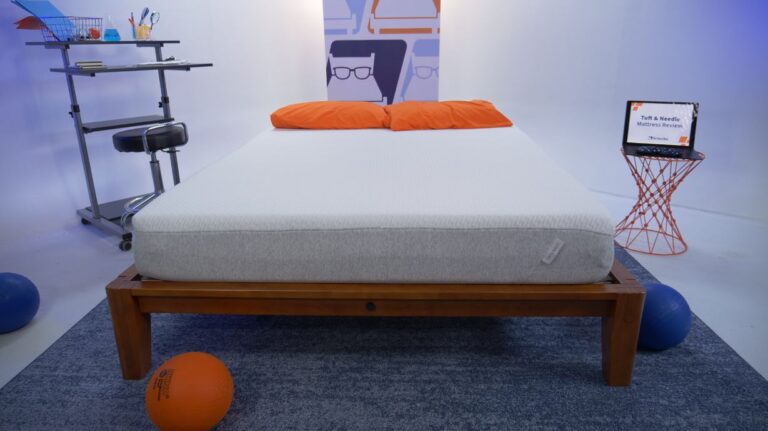
Material
Foam
Trial Period
100 nights
Shipping Method
Free shipping minus HI and AK
Firmness
Medium-firm: 6.5/10
Warranty
10-year limited warranty
Price Range
$$$$$
Back Sleeping
Ideal for lightweight and average weight back sleepers.
Stomach Sleeping
Ideal for lightweight stomach sleepers.
Financing Options
Tuft & Needle Mattress

Material
Foam
Warranty
10-year limited warranty
Firmness
Medium-firm: 6.5/10
Shipping Method
Free shipping minus HI and AK
Trial Period
100 nights
Price Range
$$$$$
Back Sleeping
Ideal for lightweight and average weight back sleepers.
Stomach Sleeping
Ideal for lightweight stomach sleepers.
Financing Options

Tuft & Needle Mattress
Material
Foam
Firmness
Medium-firm: 6.5/10
Trial Period
100 nights
Warranty
10-year limited warranty
Shipping Method
Free shipping minus HI and AK
Price Range
$$$$$
Back Sleeping
Ideal for lightweight and average weight back sleepers.
Stomach Sleeping
Ideal for lightweight stomach sleepers.
Financing Options
The Tuft & Needle mattress has a simpler construction than the Polysleep mattress: It includes just two layers of foam, one with a graphite infusion to help keep sleepers cool.
Though the Polysleep has higher pricing than the T&N mattress, antimicrobial properties come built into every version of the Polysleep mattress. Antimicrobial treatment is available in the Tuft & Needle, but customers will have to pay an extra charge.
See our full Tuft & Needle Mattress Review to learn more.
Polysleep Mattress vs. Casper Original Mattress
The original mattress that made the brand famous, the Casper is known for suiting all sleep positions. Casper's Zoned Support feature is engineered to support the hips, shoulders, and back to keep the spine aligned. And at an affordable price point, this mattress is hard to beat.
We recommend this mattress for the following sleeper types: Financing options are available for this mattress. "From the delivery of the box to the magical unfolding of the king size mattress to the first time laying on the bed, all smiles here! I have traveled for work for years, often sleeping on different beds at different hotels night after night."
The original mattress that made the brand famous, the Casper is known for suiting all sleep positions. Casper's Zoned Support feature is engineered to support the hips, shoulders, and back to keep the spine aligned. And at an affordable price point, this mattress is hard to beat.
We recommend this mattress for the following sleeper types: Financing options are available for this mattress. "From the delivery of the box to the magical unfolding of the king size mattress to the first time laying on the bed, all smiles here! I have traveled for work for years, often sleeping on different beds at different hotels night after night."
The original mattress that made the brand famous, the Casper is known for suiting all sleep positions. Casper's Zoned Support feature is engineered to support the hips, shoulders, and back to keep the spine aligned. And at an affordable price point, this mattress is hard to beat.
We recommend this mattress for the following sleeper types: Financing options are available for this mattress. "From the delivery of the box to the magical unfolding of the king size mattress to the first time laying on the bed, all smiles here! I have traveled for work for years, often sleeping on different beds at different hotels night after night."
Casper Original Mattress
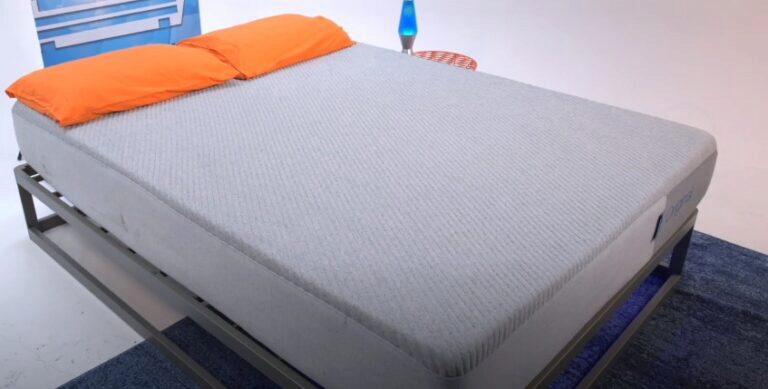
Material
Foam
Trial Period
100 nights
Shipping Method
Free shipping
Firmness
Medium-firm: 6/10
Warranty
10-year limited warranty
Price Range
$$$$$
Couples
This bed has great motion isolation so you will not feel your partner tossing and turning at night.
Seniors
This bed is perfect for senior sleepers.
Back Pain
This bed is perfect for anyone suffering from back pain.
Financing Options
Casper Original Mattress

Material
Foam
Warranty
10-year limited warranty
Firmness
Medium-firm: 6/10
Shipping Method
Free shipping
Trial Period
100 nights
Price Range
$$$$$
Couples
This bed has great motion isolation so you will not feel your partner tossing and turning at night.
Seniors
This bed is perfect for senior sleepers.
Back Pain
This bed is perfect for anyone suffering from back pain.
Financing Options

Casper Original Mattress
Material
Foam
Firmness
Medium-firm: 6/10
Trial Period
100 nights
Warranty
10-year limited warranty
Shipping Method
Free shipping
Price Range
$$$$$
Couples
This bed has great motion isolation so you will not feel your partner tossing and turning at night.
Seniors
This bed is perfect for senior sleepers.
Back Pain
This bed is perfect for anyone suffering from back pain.
Financing Options
The Casper is a popular bed-in–a-box foam mattress. Like the Polysleep, it has three layers of foam, and is sold at similar price points. It has a slightly firmer, more supportive feel overall, making it a better choice for back sleepers and lightweight stomach sleepers.
The Casper also has an ergonomically zoned support system in the transition layer, which is softer at the shoulders for pressure relief and firmer at the hips for extra lift. In general, we think side sleepers will get better pressure relief on the Casper. Couples will also notice better motion isolation. However, the Polysleep stays cooler and is the better option for hot sleepers.
See our full Casper Mattress Review to learn more.
Polysleep Mattress vs. Nolah Mattress
The Nolah Original 10” mattress is made of three layers of AirFoam and wrapped in a soft, breathable viscose fabric cover that helps moisture evaporate to keep you dry and cool.
We recommend this mattress for the following sleeper types: Financing options are available for this mattress. The Nolah Original 10” mattress is made of three layers of AirFoam and wrapped in a soft, breathable viscose fabric cover that helps moisture evaporate to keep you dry and cool.
We recommend this mattress for the following sleeper types: Financing options are available for this mattress. The Nolah Original 10” mattress is made of three layers of AirFoam and wrapped in a soft, breathable viscose fabric cover that helps moisture evaporate to keep you dry and cool.
We recommend this mattress for the following sleeper types: Financing options are available for this mattress.Nolah Original 10" Mattress
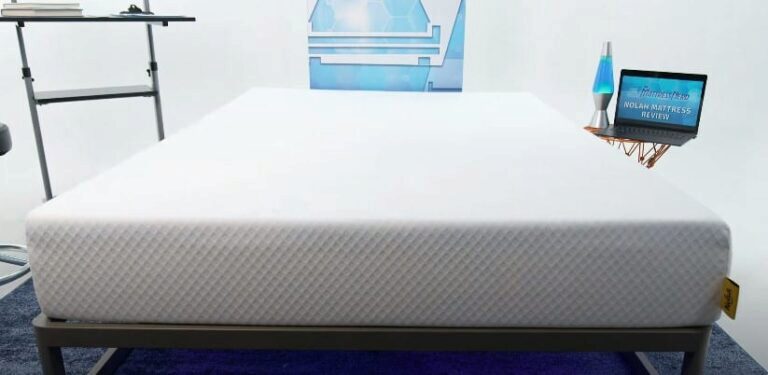
Material
Foam
Trial Period
120 nights
Shipping Method
Free shipping
Firmness
Medium-firm: 6/10
Warranty
Lifetime warranty
Price Range
$$$$$
Back Sleeping
Ideal for lightweight and average weight back sleepers.
Side Sleeping
Ideal for lightweight and average weight side sleepers.
Financing Options
Nolah Original 10" Mattress

Material
Foam
Warranty
Lifetime warranty
Firmness
Medium-firm: 6/10
Shipping Method
Free shipping
Trial Period
120 nights
Price Range
$$$$$
Back Sleeping
Ideal for lightweight and average weight back sleepers.
Side Sleeping
Ideal for lightweight and average weight side sleepers.
Financing Options

Nolah Original 10" Mattress
Material
Foam
Firmness
Medium-firm: 6/10
Trial Period
120 nights
Warranty
Lifetime warranty
Shipping Method
Free shipping
Price Range
$$$$$
Back Sleeping
Ideal for lightweight and average weight back sleepers.
Side Sleeping
Ideal for lightweight and average weight side sleepers.
Financing Options
The Nolah is another all-foam mattress with three distinct layers. It has a medium-firm feel and uses Nolah’s special AirFoam to provide body contouring and pressure relief, especially for side sleepers. Like the Polysleep, it’s easier to move on than a memory foam mattress.
The Nolah and Polysleep work well for similar sleeper types, but because the Nolah is more pressure-relieving than the Polysleep, side sleepers may enjoy it more. However, it’s not quite as temperature-regulating as the Polysleep, so we don’t recommend it to hot sleepers.
See our full Nolah Mattress Review to learn more.
Polysleep Mattress FAQs
What mattress has the best ratings on the market?
According to our mattress testing scores, the Bear Pro memory foam mattress earns top marks. Brooklyn Bedding and Helix also make high scoring mattresses. If you’re looking for a natural bed, consider the Awara mattress. The Polysleep mattress is best for budget-conscious shoppers who want a basic foam bed.
Who owns Polysleep?
Polysleep is a Canadian bed-in–a-box mattress company that’s based in Montreal, Canada. It’s a relatively new mattress company, launched by Jeremiah Curvers in 2016. Since then, Polysleep has expanded into three mattresses and other bedding items designed to provide better sleep. Now, you can also buy Polysleep mattresses on Amazon.
Is the Polysleep mattress good?
We recommend the Polysleep to those with lightweight and average-weight body types (under 230 lbs), especially back sleepers, as well a hot sleepers.The open-cell top layer of foam gives the mattress more airflow than most all-foam beds, and it’s also antimicrobial to prevent collection of bacteria and to reduce allergies.
What’s the Bottom Line?
The Polysleep mattress is made with three layers of polyfoam that, together, have a medium firmness level. The contouring top layer makes it a great choice for back sleepers who need cushioning that’s balanced with support. It features a liquid-repellent cover that makes it appealing for a child’s bedroom.
It’s also good for hot sleepers, since the foam layers are more breathable than we typically see in foam beds. If you’re looking for an affordable all-foam mattress, the Polysleep is a good option, with a Queen size costing less than $1,000 during sales.
